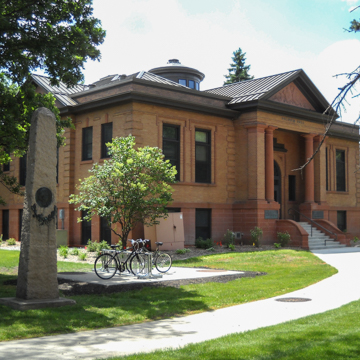You are here
Putnam Hall (Carnegie Library)
NDSU’s former Carnegie Library, known for many years as Putnam Hall after music director Clarence S. “Doc” Putnam, is another product of the brief architectural career of Albrant. The Classical Revival, cross-plan brick building is on a foundation of dressed sandstone. The entrance has sandstone Tuscan columns distyle in antis. Windows on the sides and rear elevation have jack-arched lintels and keystones. The building concludes with a heavily dentiled cornice around pedimented gables and the roof is surmounted by a small cupola. The standing-seam metal replacement roof, though practical, changes the effect of what was originally a more delicate cedar-shingled roof. Entrance from the north was originally emphasized by an ornamental pond and landscape plantings. The building is clearly too small to serve the needs of a modern university research library, but it continues to contribute in many significant ways to the character and perception of the historic campus.
Writing Credits
If SAH Archipedia has been useful to you, please consider supporting it.
SAH Archipedia tells the story of the United States through its buildings, landscapes, and cities. This freely available resource empowers the public with authoritative knowledge that deepens their understanding and appreciation of the built environment. But the Society of Architectural Historians, which created SAH Archipedia with University of Virginia Press, needs your support to maintain the high-caliber research, writing, photography, cartography, editing, design, and programming that make SAH Archipedia a trusted online resource available to all who value the history of place, heritage tourism, and learning.


